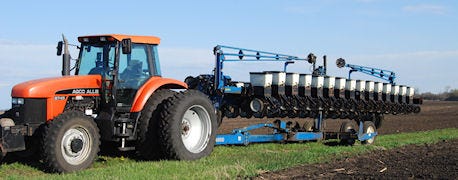March 26, 2013

The USDA Risk Management Agency has specific rules about early planted crops with regard to multiperil crop insurance coverage. Iowa State University Extension farm management specialist Steve Johnson offers the following explanation and guidelines.
"Acres of insured crops planted before the designated early planting dates aren't eligible for replant coverage," he notes. "Also, if you are planting an insured crop, you need to be keeping track of each field's planting date."

EARLY PLANTING DATES: There are rules for early planted crops with regard to crop insurance. Acres planted before specific dates aren't eligible for replant coverage. The earliest planting dates allowed for counties in Iowa are April 11 for corn and April 21 for soybeans. All acres planted before these dates still have full crop insurance coverage for yield or the revenue guarantee. The replant coverage is what you give up when you plant before the early planting date.
For each county and crop, RMA has set an "early planting date" for farm-level products such as Revenue Protection and Yield Protection. The earliest planting dates allowed for counties throughout the state of Iowa are April 11 for corn and April 21 for soybeans. Dates will vary in other states and sometimes counties.
In Iowa the early planting date is April 11 for corn, April 21 for soybeans
Acres planted before these dates are no longer eligible for replant coverage payments should it be necessary to replant. The maximum replant payments each year are equal to 8 bushels of corn and 3 bushels of soybeans. Multiply these bushels times the RMA projected price for that year, which is the February average futures price for December corn and November soybeans used to establish the value of the insurance guarantees that the producer purchases. For 2013 the projected prices are $5.65 per bushel for corn and $12.87 for soybeans, so the maximum replant payments are $45.20 or $38.61 per acre, respectively.
Any acres planted before the early planting dates lose replant coverage, even if the entire farm or insurance unit hasn't been planted. However, early planting doesn't affect a farm's actual production history (APH) yield or revenue insurance guarantee, as long as all other good management practices are followed throughout the growing season. Once the crop is planted, that revenue guarantee is still in effect, and any indemnity payments will depend on the final harvested yield and the harvest price.
Are you willing to take the risk of early planting?
* Balancing risk vs. reward. Are you willing to take the risk of early planting and possibly having damage occur? The reward could be an early plant emergence ahead of weed competition, improved yields because of early corn pollination or perhaps a higher cash price for delivering bushels in early September.
But what if frost hits in mid-May and damages the plant stand and potential yield? If the corn was planted prior to April 11 or soybeans before April 21, the crop insurance would no longer provide a replant payment on those acres.
What if the reason you have to replant isn't necessarily freeze or frost related? For example, what if corn acres planted before April 11 are flooded or hailed out in mid-May; do you still have to replant? Your crop insurance agent should be notified within 72 hours of discovery of the loss. Following the likely visit by a crop insurance adjuster, loss will be estimated including a plant stand and determination of maturity and yield potential of existing plants.
~~~PAGE_BREAK_HERE~~~
Keep in mind all acres that were planted early still have full crop insurance coverage for yield, or the revenue guarantee. The replant coverage is what you give up when you plant before the early planting date.
If you plant an insured crop, keep track of each field's planting date
* Keeping track of planting dates. Everyone who plants an insured crop should keep track of what date they planted each field and how many acres were planted to that crop. That information has to be reported to your local Farm Service Agency office on FSA form 578; the acreage report. You will likely be asked to document that information by FSA farm and tract number.
For 2013, this information must be filed by July 15 to your local FSA office. A copy of the FSA form 578 should be provided to your crop insurance agent. Note that this date is slightly later than the typical June 30 deadline in Iowa.
Since the Risk Management Agency has moved up to August 15, providing a copy of your acreage report well in advance of the July 15 deadline will assure more timely crop insurance data entry and receipt of your premium notice. The 2013 crop insurance premium is due earlier than in past years. To avoid a penalty, payment must be received by your agent on or before October 1, 2013.
Always contact your crop insurance agent if you have particular questions or concerns regarding your coverage.
For farm management information and analysis go to ISU's Ag Decision Maker site www.extension.iastate.edu/agdm and ISU Extension farm management specialist Steve Johnson's site www.extension.iastate.edu/polk/farm-management.
You May Also Like




